Splendor review: a modern board game gem
Splendor is an easy-going game of building a gemstone empire that's perfect for beginners, but has enough strategy to satisfy the competitive
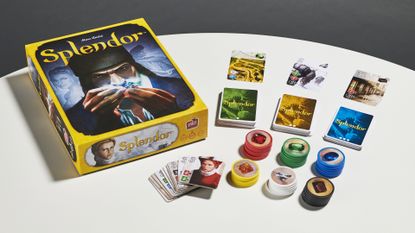
Splendor is a compact game that builds to being totally engrossing. It's easy to understand, simple to play and lets you play with poker chips between rounds. What's not to love?
-
+
Understandable economic strategy
-
+
A real feeling of progress as you play
-
+
Gorgeous art and components
-
-
Slow turns may drag
-
-
A bit lightweight for some
Why you can trust T3

Splendor is a breezy board game of building an empire of gemstone cards, which you pay for using gemstones. It's an all-gem economy. The satisfying thrill to this game is the way things build – every card you buy makes it easier to buy things in the future, giving you even more buying power, making it possible to buy even more prestigious cards.
It's a snowball rolling down a hill and getting larger and larger, but made of diamonds. And much like a giant snowball made of diamonds, if you don't stay ahead of things, you're done for – you see, this is also a race to get to a set number of points. First to 15 wins, and you'll find that once people start getting close to that mark, thing progress rapidly.
It's a really good board game for beginners, and works well with any number of players, making it a great two-player board game. We also recommend it as one of the best Monopoly board game alternatives – it has the same feeling of collecting to build something, but without all the downsides. Oh, and Splendor has maybe the only currency in board gaming that's better than Monopoly's famous paper money…
So, with all that said, read on to get T3's full Splendor review and find out if this is a board game you should add to your collection.
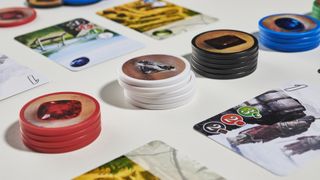
Splendor review: Price, and who it's for
Available for around £22/$35/AU$60, Spendor is a fairly inexpensive game, and the box is pleasingly small – a little bigger than a hardback book. It comes with a custom inlay to keep its components perfectly organised, which is always a deeply pleasing touch. But not as pleasing as the custom poker chips it comes with, to represent the gems. I'm not saying these are the best part about the game, because that would be ridiculous. But I'm not not saying it.
Lots of games come with little plastic gems to represent gems, but obviously those will always feel cheap. While a weighty poker chip might not resemble a gem, the feeling of tossing one across the table has an important and premium feel that's much more in the spirit of being a gem magnate then plastic would achieve.
The recommended age of 10+ seems like a good guideline, though we expect that a lot of younger kids would be able to understand the game (and there's no text at all, the whole game is symbol based, basically), but the theme is fairly dry, so it will just depend on whether you think they'll engage with it.
It's for two to four players, and works well at all player counts. The only adjustment is how many poker chips you have available – you reduce the total when there are fewer players, so that there's a constrain on supply. It will certainly be slower to play with four, though – a two-player game will likely last 30 mins, but expect three players to go more like 40 mins, and four players a bit longer still, unless you're all experienced in it.
Splendor will find its biggest fans among people who like their games to be fairly gentle. There is interaction between players, but only in the sense that you're all competing to take the same resources and buy the same cards, so end up denying other people something they need, rather than battling it out directly. It has a nice sense of progress to it, yet the core game doesn't change or become more complex throughout the game. Some will want a little more to get their teeth into, but as a game you can play while catching up with friends, it's pitched at the perfect level.

Splendor review: How it plays
One of Splendor's many positive qualities is that it only takes a minute or two to set up. In the centre of everyone are three decks of cards, each at different tiers. You lay out four cards from each tier visible to everyone, and this is the 'market' that everyone is able to buy cards from. Whenever a card is taken from here, it's replaced with a new one from the deck. Tier 1 cards are fairly easy to buy, but Tier 2 cards are way out of reach at the start of the game, and Tier 3 cards won't be possible to buy until right near the end. The gem poker chips are also placed in the centre for everyone to reach – these are the currency of the game, being traded for cards.
Each card has three key pieces on information on it: at the bottom is the number and colours of gems you need to spend to buy it; at the top is the type of gem that card will add to your collection; and some cards also have a large number at the top that give you points towards the 15 you need in order to win.
On your turn, you can do one of three things: take up to three poker chip gems from the piles, which you can then use to buy cards in future turns; buy a card from the centre to add into your personal gem collection; or 'reserve' a card by removing it from the centre grid and keeping it nearby, available to buy and add to your tableau on a future turn (but now no one else can have it).
The reason the game snowballs is because every card you buy increases your spending power on future turns. I mentioned that the cards have gems at the top – when one is added to your collection, you're now able to use that gem as buying power on every single turn from now on, without having to get rid of the card or anything. You then top it up by using the gem poker chips – so if a card you want costs 2 blue gems and 1 red gem, and you already have a card with a blue gem and a card with a red gem in your collection, all you'll need is one blue gem poker chip to buy that card.
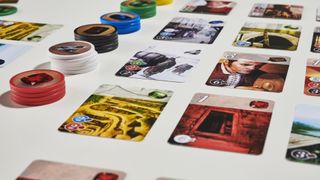
At the start of the game, you have nothing, so the first few turns are just spent picking up gem poker chips to buy one of the cards… and hoping someone else doesn't buy that one first, leaving you with a specific set of poker chips that don't work so well any more. That's one reason the 'reserve' action is such a great one – you guarantee yourself the card your after, and if you though someone else was also going for it, you've left them in the lurch. And the reserve action has an added bonus: it's the only way to get a gold poker chip, which acts as any colour of gem when buying cards. So sometimes it's good to reserve something just to have flexibility.
This slow start is what makes it so extremely satisfying to get later in the game, when you realise that your personal collection of cards you scrimped and saved for is now big enough that it enables you to just… have cards you want. No poker chips needed. "Oh, that one costs two blue, two green and two red? I have all those. I'll take this card for free, then, thanks."
But buying cards is just a means to an end. Those more affordable Tier 1 cards usually aren't worth any points at all, or very few. So the point at which you're able to afford those easily is the point at which you should already be planning to buy higher tier cards, which cost lots more. To get the higher tier cards, you'll have needed to plan ahead with the cards you bought earlier, aiming for particular higher-tier cards (and making sure that someone else doesn't get there first). The Tier 3 cards can be worth a third of the total points you need on their own, so there's a good chance you'll only end up buying one or maybe two of them the whole game, to take you over the finish line, so it all builds to there.
And there's one more wrinkle we haven't mentioned: Nobles. These sit above the decks of cards, and will probably(though not definitely) be the key to winning the game. They're worth a tidy points haul, and will simply come over to you if you meet their criteria, which is to have certain numbers of particular card types.
The reason Nobles tend to decide the game is because you don't need to spend a turn buying a Noble instead of card – they come in addition to the card. That means that if you play it right, you can be buying a 5-point card and earning a 3-point Noble all in one go. That's 8 points! Remember how the target is only 15? That's what we meant back at the start when we said things progress rapidly. Once you spot that a player might be able to get to 15 points soon, you'll realise that you need need to hoover up points as quickly as possible.
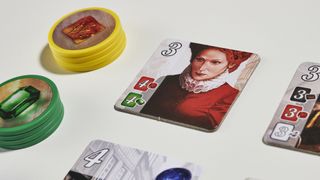
Even though there are more Nobles than there are players, somehow you also always end with multiple people hoping to get the same one – probably because at the start of the game, you were all facing the same market of cards, and all working out the same possible strategy.
There's remarkable amount of substance to Splendor considering it consists of three small piles of cards and some poker chips. And yet each turn is quite simple: you take some poker chips, or you take a card. And between turns, you think about what you're going to do next turn, and then swear at the person who buys the card you want before you get the chance.
And it's all over in less than hour, building to that big conclusion before outstaying its welcome. That goes double if people know the game well, and don't get stuck trying to analysing everything that can do on a turn. That's the only major downside to Splendor, really – if someone else is having a moment of indecision, you don't have much to do but wait.
Others may not like it due to its theme being very light, or it generally not offering a huge amount of depth compared to more expensive and elaborate economic games. But its accessibility is one of its most valuable assets.
It's also true that it's technically quite same-y each time you play, but we've never found that to be an issue, because the work you do to build your little gem empire is interesting enough on a turn-by-turn basis – followed by a dash for the points at the end – that you never notice that it feels samey, in the same way that all great card games are interesting because every turn offers interesting choices, rather than the whole game changing each time.
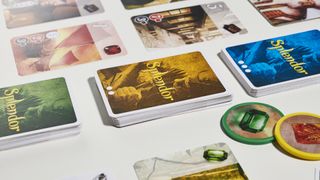
Splendor review: Verdict
Splendor is one of the best board games available to buy right now, in our opinion. It has really broad appeal – it's competitive, but not cut-throat; it's engaging, but not complicated – that makes it easy to break out over and over, with new players or old hands.
It's also pretty inexpensive, and comes in a box that's a reasonable size, and will fit on any bookshelf. If you're looking for a start in modern board games, it's a really great choice; if you already know games and want a fun economic game that can be out of the box and into a game in about three minutes max, it's also perfect.
Splendor review: Also consider
Ticket to Ride has been a favourite for a long time now, and for good reason – just like Splendor, it's easy to play but offers plenty to think about. It's a game of claiming railway routes as your own, to connect specific cities via a continuous route, which will earn you points. It has just the same simple turns as Splendor (right down to the fact that you can do one of three things), but some may find the fact that you're mapping out over a big board more satisfying than collecting gems. It tends to cost a bit more than Splendor, and is bigger and a bit more fiddly to play. There are loads of different versions available, but that's okay – we've got our guide to which version of Ticket to Ride you should buy!
If you'd like something with just a bit more complexity than Splendor, we'd recommend Istanbul as the next step up. It's still got quite a chilled-out tempo and isn't too complex, but it gives you a lot more options and variety. You're aiming to be the first trader to gain a certain number of rubies. You can get rubies by buying them with currency or trading goods. How do you get goods and currency? You go around the market of Istanbul, making deals! There are lots of ways to tackle the game, and it has a clever system where things become harder to do the more time people do them, so it pays to take different tactics to everyone else.
If you'd like something that really leans into the lovely components and aesthetics that Splendor hints at, and is roughly the same level of complexity, try Azul. It's a game of building a beautiful patterned tile wall over time, scoring more points the more neatly you build your wall. But there's an ingenious puzzle at its heart: you can take basically any colour of tile you want from the options in the centre, but any choice to make leaves your opponents with more tempting options. Is it more important to you to get what you want, or to make sure they don't get what they want? The only fiddly element of Azul is scoring, but even that's really not hard in the grand scheme, and is explained clearly enough in the rulebook.
Sign up to the T3 newsletter for smarter living straight to your inbox
Get all the latest news, reviews, deals and buying guides on gorgeous tech, home and active products from the T3 experts
Matt is T3's former AV and Smart Home Editor (UK), master of all things audiovisual, overseeing our TV, speakers and headphones coverage. He also covered smart home products and large appliances, as well as our toys and games articles. He's can explain both what Dolby Vision IQ is and why the Lego you're building doesn't fit together the way the instructions say, so is truly invaluable. Matt has worked for tech publications for over 10 years, in print and online, including running T3's print magazine and launching its most recent redesign. He's also contributed to a huge number of tech and gaming titles over the years. Say hello if you see him roaming the halls at CES, IFA or Toy Fair. Matt now works for our sister title TechRadar.
-
 Apple's bold message with Silo is foresight that Netflix should learn from
Apple's bold message with Silo is foresight that Netflix should learn fromSilo has been commissioned by Apple TV+ to its conclusion – if only other streaming services had such foresight
By Mike Lowe Published
-
 Kickstart your metabolism and burn fat in 30 minutes with this five-move bodyweight workout
Kickstart your metabolism and burn fat in 30 minutes with this five-move bodyweight workoutIt'll also boost your aerobic capacity and functional strength too!
By Bryony Firth-Bernard Published
-
 Prime Video's new cop series looks scarily realistic
Prime Video's new cop series looks scarily realisticOn Call seems like it could be pure stress
By Max Freeman-Mills Published